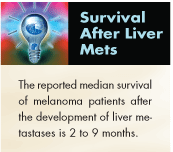Hepatic Arterial Chemoembolization (HACE) May Prolong Survival in Melanoma Patients With Liver Mets
Hepatic Arterial Chemoembolization (HACE) May Prolong Survival in Melanoma Patients With Liver Mets
SEATTLEAbout one-third of patients with liver metastases of melanoma have a response to hepatic arterial chemoembolization (HACE), and these patients have a median overall survival exceeding 15 months, Judy Ahrar, MD, said at the Society of Interventional Radiology annual meeting (abstract 154).
"The liver is a common site for metastasis from melanoma, particularly for ocular melanoma, where liver-only metastasis has been reported in 40% to 50% of patients at initial diagnosis," said Dr. Ahrar, an assistant professor at M.D. Anderson Cancer Center.
Dr. Ahrar and her colleagues undertook a retrospective review to evaluate the response to and survival after HACE in patients with liver metastases from melanoma treated at the center between 1992 and 2005. They determined objective tumor response by comparing baseline scans with follow-up scans, using WHO criteria. "One of the limitations that we came across when we were evaluating objective tumor response is that the WHO criteria do not take into account the degree of necrosis on imaging," she noted. This can be problematic, she said, because HACE sometimes produces marked necrosis without any change in tumor size.
Records were reviewed for 181 patients who had a mean of 2.1 HACE sessions (range, 1 to 8). The chemotherapeutic agent used was cisplatin in all patients; the embolic material used was either absorbable gelatin (Gelfoam) or polyvinyl alcohol (PVA) particles. Slightly more than 70% of patients had ocular melanoma, while 25% had cutaneous melanoma; 4% had an unknown primary site, and less than 1% had rectal melanoma. More than half (52%) had experienced a failure of previous systemic therapy.

The median follow-up from the day of first embolization was 6.3 months (mean, 10.8 months) in the 152 patients with evaluable radiologic results, Dr. Ahrar said. About 12% of patients had a partial response, 18% had a minimal response, 61% had stable disease, and 9% had progressive disease. Median overall survival was 7.3 months, and median progression-free survival was 4.9 months.
"We compared the ocular vs cutaneous melanoma groups. In terms of response rates, progression-free survival, and overall survival, there was no significant difference between the two groups based on the standard log-rank test," Dr. Ahrar noted. In contrast, there was a significant difference according to the HACE response: Compared with their counterparts who had stable or progressive disease, patients who had a partial or minimal response had an overall survival that was more than twice as long (15.3 vs 6.8 months).
"HACE results in radiologic response or at least stabilization in the majority of patients91.5% in the present series," Dr. Ahrar concluded, noting that the benefit occurs mainly in the one-third of patients who have a response. "Patients who do not show a measurable radiologic response are not likely to benefit from additional HACE sessions," she said.